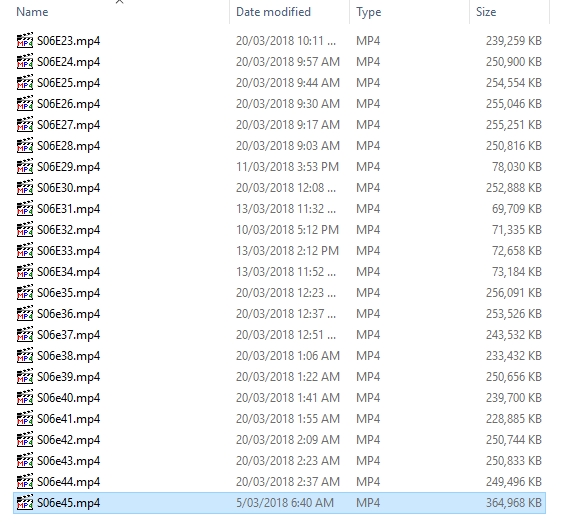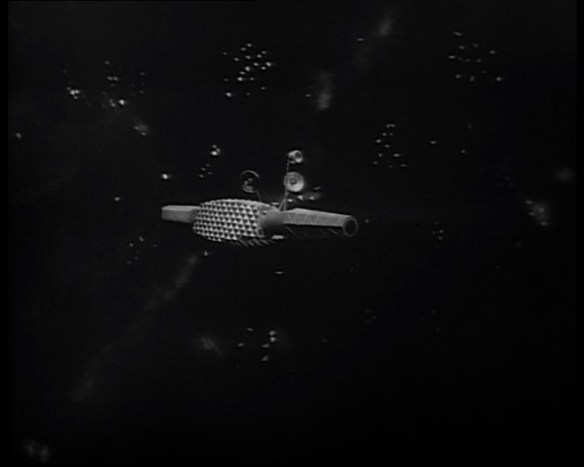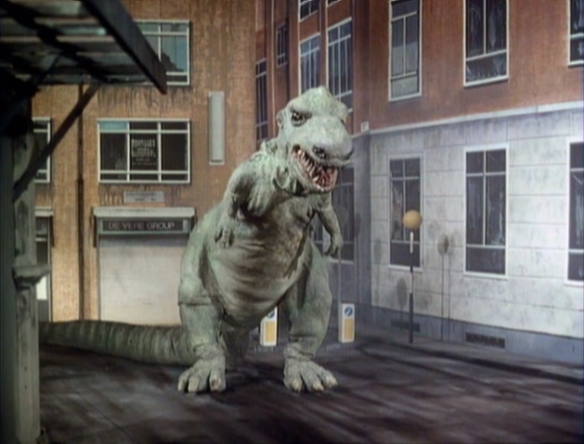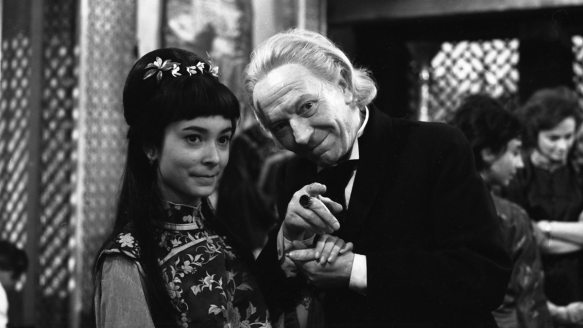I have been watching through original Doctor Who with my kids from the very first William Hartnell episode. We’re enjoying it, so I thought I’d share our DW routine to maybe inspire other parents, fans, or New Who folks to give it a try.
My pair are 7 and 9, and we’ve been watching from the very beginning for a while now. At this point we’re into Patrick Troughton’s last season. In fact, we’re now up to part three of The Space Pirates.
Watching is a part of our morning school routine – get up, eat brekky, get dressed, brush hair, one 25 minute episode, then out to catch the school bus. If they’re going a bit slow I remind them, “If you don’t hurry up, there won’t be time for today’s Doctor Who!”
That gets them moving!
Every month or two they ask for some old Warner Brothers cartoons or My Little Pony for a few mornings, then I find them slightly more reluctant to break that habit and go back to DW. Kids like routine, so if the routine changes they quickly become comfortable with the new one. But after a few mornings I tell them that I’m watching the next episode of Who, if they don’t want to they can do something else. Within minutes of it starting they’re back in the groove and it’s our schoolday routine once more.
In fact, it’s too much a school routine. Come the holidays we’re flat out getting around to a single episode. But that’s okay, the break just makes us more eager for it when school starts again.
Now with showing them stories, I do my best to keep all the surprises. I don’t tell them anything about the episode we’re watching – except for when a companion dies. They like to know in advance on that stuff because they find it really upsetting. So I usually warn them at the start of the story, and again when the actual episode comes around.
With regards to hiding the surprises, I take the hiding info to silly extremes.

So episode 10 of The War Games is S06E44 and… wait… E45?!
I dump my DVDs down to the computer, and then across to a flash drive. On the flash drive the only info they have is what season and what episode number it is – no names. That way they have no idea of story lengths, which works especially well in the early era when episode length varied quite markedly. Not knowing when a story will end adds to the thrill for them. [1]
When starting a new story I’ve gotten into the habit of skipping the opening titles, too. That way they don’t get told it’s a Dalek story in the title, then have a bunch of characters talking about the evil enemy they’re up against, that they never quite get around to naming, only to have a “shock reveal” at the cliffhanger – Yes, I’m looking at you, Terry Nation!
I also refuse to tell them when a regeneration story is coming. Oh, the number of stories where the Doctor gets hurt and they start to worry that it’s a regeneration story. And of course that meant they were completely blindsided by Hartnell’s regeneration when it came about.
I suspect Troughton’s is going to shock them too, when the time comes. Of course now I’ve taken to pretending to film them towards the end of random episodes. First time I did it, they thought it was a regeneration, which was the point. Doing it a few more times before his last episode.
As an aside, I also managed to keep the Doctor’s regeneration into a woman quiet from my daughter. Son found out three months out, but he did a great job of not telling his sister, so she got the full effect at the end of Capaldi’s run.
For me the lengths are worth it. When I was a kid, the only way to experience the majority of these stories was to read about them in novelisations, articles, or books. So when one finally, and often unexpectedly, got the chance to see them, you already knew that it was the first appearance of whatever, or that such and such left, or that the Doctor regenerated.
I’m trying to give them all the surprises I was denied.
I do it with films, too. Showed them Planet of the Apes as soon as they were old enough to understand the significance of the ending, but before it could be ruined for them because it’s a pop cultural touchstone. Same with the reveal in The Empire Strikes Back. I’ll do the same with Citizen Kane, Psycho, and Fight Club one day.
You might notice I’m avoiding spoilers here for everything I’m talking about. There’s always somebody for whom the thing you’re discussing is new. I feel in a more general discussion it doesn’t hurt to talk around such details because everyone who has seen it knows exactly what you mean, and you’re still saving the surprise for those that haven’t had the chance.
Some folks might think that kids wouldn’t take to the old show. Sorts of things I hear are the effects are too crappy for modern day kids, or the stories are too slow.
First up, my children are sci-fi savvy. They’ve seen a range of stuff including most of the Star Wars films, and when they recently saw this spaceship in Wheel in Space –

Yes, this spaceship blew away kids who’ve seen Star Wars – you have to check your preconceptions
Their reaction was a genuine and enthusiastic “Oh wow!”
Children don’t view these things the way we do. We’re denying them a chance to connect with something if we decide for them that they won’t like it. It’s one thing to cater to their tastes and avoid things they find distressing, it’s another to hamstring storytelling variety without giving them the chance to experience it.
They have also seen various Ray Harryhausen films and the first Jurassic Park film. Shortly after Jurassic Park we watched Invasion of the Dinosaurs because I’d mentioned a DW story had dinosaurs. Here’s one of the dinosaurs –

This dinosaur is kinda the star, it appears all through the story, often in close up.
My children’s reaction? Well, initially there was a bit of “They look a bit rough,” but in a very short space of time, they were caught up in the story. They were scared for the characters, even though they could easily identify the use of puppets and Chromakey, and they got really upset when one dinosaur was being hurt.
This is the thing many adults forget. Children love stories. Effects and budget are only a delivery system for the storytelling.
Most kids are wonderfully empathic and thoughtful about appreciating a story on its own terms. That’s why even if you’re not good at reading stories aloud, they still love you doing it – they don’t care about the medium, they care about the story and characters. You reading it to them adds an extra layer of special to that.
If the story and characters are good, it doesn’t matter to kids if it’s told with sock puppets, stick figures, or shadows. Yes, they like pretty graphics, but they care about good storytelling a lot more.
This also addresses the storytelling pace of old Doctor Who. Many children I know of like the slower pace. Old DW is told at a pace and in a way where everything is quite clear. The nature of television from that period demanded it because it was only ever made to be seen once and never again. Kids have time to take in the characters and the story and really get a handle on what is happening.
Children want to understand as much of the story as possible and the slower storytelling makes them feel more in control as an audience member.
Don’t get me wrong. My kids love fast paced stuff, but they seem to enjoy slower storytelling a lot more. And I don’t get anywhere near as many questions about what is happening. When I do get questions the answer is almost always, “Watch and listen, and you’ll find out.”
Also, with regards to pacing, even the slowest story is easy to take when only watched at the rate of one 25 minute episode per day. We’ve had a lot of stories that many adult fans consider boring (usually they’ve watched them in one sitting), where my kids have been demanding the next episode immediately, because they didn’t want to wait until the next day. I made them wait, of course!
I suppose the last element to address is watching reconstructions of the missing episodes. I go for telesnap reconstructions because, well, it’s usually photos from the actual story. Combined with the existing soundtracks, and occasionally a bit of existing footage, this is pretty much as close as one can get to watching a missing episode.
Again, this is something that a lot of adults seem to think kids won’t like. But it’s really no different to those Read-Along books that come with a CD (or tape, or record, if you’re an old bugger like me) where the story is told and you turn the page at the sound. They still sell these and it’s because children love them!
The telesnap reconstructions often have text on screen to explain bits of the action that aren’t obvious. When we started going through these stories I had to read out the actions for my daughter, but she’s old enough that she’s reading them all herself now.
The first story we watched that was reconstructed was Marco Polo, of course. Out of the first four stories, Marco Polo was my daughter’s favourite – even over the first Dalek story. The kids quickly got used to telesnap reconstructions to the point where my son would occasionally be halfway through an existing episode of a mostly missing story before he came out with, “Hey, this episode has footage!”

Much as I’m a Doctor Who fanboy, Marco Polo is one of the very few stories I’ve ever rated 10/10
There are of course official animated reconstructions of a few stories and episodes available on DVD. I haven’t shown the kids any of these as I personally find them highly variable. Some are very good, some feel somewhat lacklustre. I think Power of the Daleks is one of the best there is, but I still prefer the recon.
That said, I will let them watch the animated ones on later viewings, if that’s their preference. For now, I want them to get the as close as possible to the original experience. Many of the telesnap reconstructions can be found on DailyMotion or Youtube now!
There are also numerous fan animations on Youtube. I steer clear of most of these as I just found too many that decided to make things cooler by adding in elements that wouldn’t have been doable in the original show, such as flying Daleks in the jungles of Kembel, or sweeping impractical camera moves.
And as I said, my kids have been completely fine with the telesnap recons. They react to revelations and excitement at about the same level as they do with existing stories.
So that’s it. That how we’ve been approaching watching from the beginning. It’s also been good because there were a handful of Troughton stories I’d never gotten around to seeing, and I got to watch a couple of them for the first time ever with my kids. Have seen two of them, now just have Space Pirates and War Games[2] to go!
If you’re someone with children who has been thinking about watching the classic series, I’d recommend it. Experiencing these stories with my children has allowed me to view the show through fresh eyes, which has been something of a gift in itself. Seeing their excitement, the way they connect and get scared or elated – it’s really a lovely thing to share.
Cheers,
Danny
1. In fact, as we near the end of season 6, I’ve actually labelled the first few episodes of of the seventh season as S06E45, E46, E47 just to further muddy the waters. Kids are smart, they soon learn to pick up on little clues. BACK TO POST
2. Yes, I haven’t seen War Games. Some years ago I decided I wanted to see it in the context of the other stories. But every time I was working through all the Troughtons, I’d get most of the way through season 5 and something would happen to stop me watching for months and months.
So, when I was finally ready to go again, it’d been that long I either started again at the start of the Troughtons, or in one case, back at the Hartnells. And then life would blow up again at some point in season 5! BACK TO POST

Reblogged this on Pirates of the Burley Griffin and commented:
This lovely piece on parenting and Doctor Who is WELL worth your time. Reblog so I’ll be disabling comments here, please click through and give your appreciation for this wonderful story to Danny directly.
This is really lovely Danny, I may be sharing it around a bit (OK, a lot) so it can get the attention is deserves. 🙂
Aw thank you! I’m glad you like it 🙂